Tajhat Palace
Tajhat Palace, Tajhat Rajbari, is a historic palace of Bangladesh, located in Tajhat, Rangpur.[1] This palace now holds the Rangpur museum.[2] Tajhat Palace is situated three km. south-east of the city of Rangpur, on the outskirts of town.
Tajhat Rajbari | |
Tajhat Palace from front | |
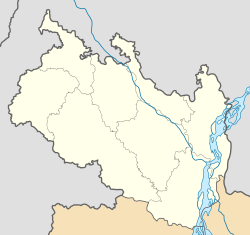 Location within Rangpur division | |
| Location | Bangladesh, located in Tajhat, Rangpur |
|---|---|
| Coordinates | 25.7251°N 89.2804°E |
| Accreditation | Department of Archaeology (Bangladesh) |
Structure
The palace, with about 76 metres frontage, rises two storeys and faces east. An imposing broad staircase in the centre, paved with imported white marble, leads directly above the portico to the upper storey.
The palace is crowned by a ribbed conical dome in the centre of the roof with a tall octagonal neck, partly supported on a series of slender semi-Corinthian columns. The balustrade on either side of the imposing staircase was originally embellished with various sculptures of classical Roman figures in Italian marble, but now these are missing. There are two semi-octagonal projections at each end of the front face and a central projecting porch. The balcony roof above the porch is carried on four graceful Corinthian columns with round shafts, while two similar columns on each of the projecting ends of the building support a triangular gable.
The palace is laid out in the form on a "U", with its open end to the west. Beyond the entrance at ground-floor level there is a very large hall, measuring more than 18 x 13 meters. A 3 meter wide corridor runs the entire length of the inner block. Two broad wooden staircases provide access to the upper floor. There are about 22 apartments on two floors.
History
The palace was built by Maharaja Kumar Gopal Lal Roy in the beginning of the 20th century. It is believed that from the conspicuous appearance of his Taj or jeweled crown, his estate derived the name of Tajhat.
From 1984 to 1991 the palace was used as a Rangpur High Court Branch of the Supreme Court of Bangladesh. In 1995 the palace was declared as a protected monument by the Department of Archaeology. Recognizing its outstanding architectural value the Government of Bangladesh shifted the Rangpur Museum to the second floor of the palace in 2005. The main room at the top of the marble stairs have a number of display cases which show 10th–11th century terracotta artifacts. There are a number of fine examples of Sanskrit and Arabic manuscripts, including copies of the Mahabharat, Ramayan, and a Quran whose provenance is attributed to none other than the Mughal Aurangzeb. The back rooms have several examples of black stone Hindu carvings in its back rooms, mainly of the deity Vishnu. Photography is not permitted in the museum itself.
Gallery
- Entrance view
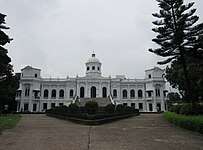 Close Front of Tajhat Palace
Close Front of Tajhat Palace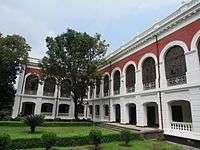 Backyard court
Backyard court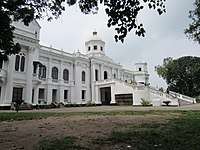 Side view
Side view- Another view
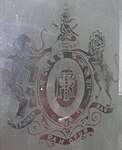 The Coat of Arms of Maharaja Gopal Lal Roy as depicted on a ground floor French Door window panel
The Coat of Arms of Maharaja Gopal Lal Roy as depicted on a ground floor French Door window panel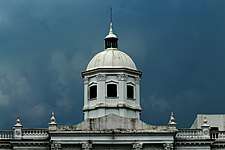 Top of palace
Top of palace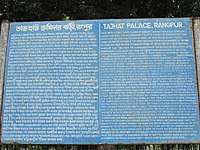 Brief history of Tajhat palace
Brief history of Tajhat palace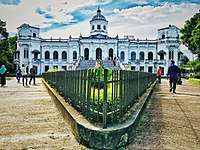 Another view
Another view
References
| Wikimedia Commons has media related to Tajhat Palace. |
- Abdus Sattar (2012), "Rangpur Sadar Upazila", in Sirajul Islam and Ahmed A. Jamal (ed.), Banglapedia: National Encyclopedia of Bangladesh (Second ed.), Asiatic Society of Bangladesh
- Shafiqul Alam (2012), "Department of Archaeology", in Sirajul Islam and Ahmed A. Jamal (ed.), Banglapedia: National Encyclopedia of Bangladesh (Second ed.), Asiatic Society of Bangladesh
External links
- Muhammad Moniruzzaman (2012), "Ray, Gopal Lal", in Sirajul Islam and Ahmed A. Jamal (ed.), Banglapedia: National Encyclopedia of Bangladesh (Second ed.), Asiatic Society of Bangladesh